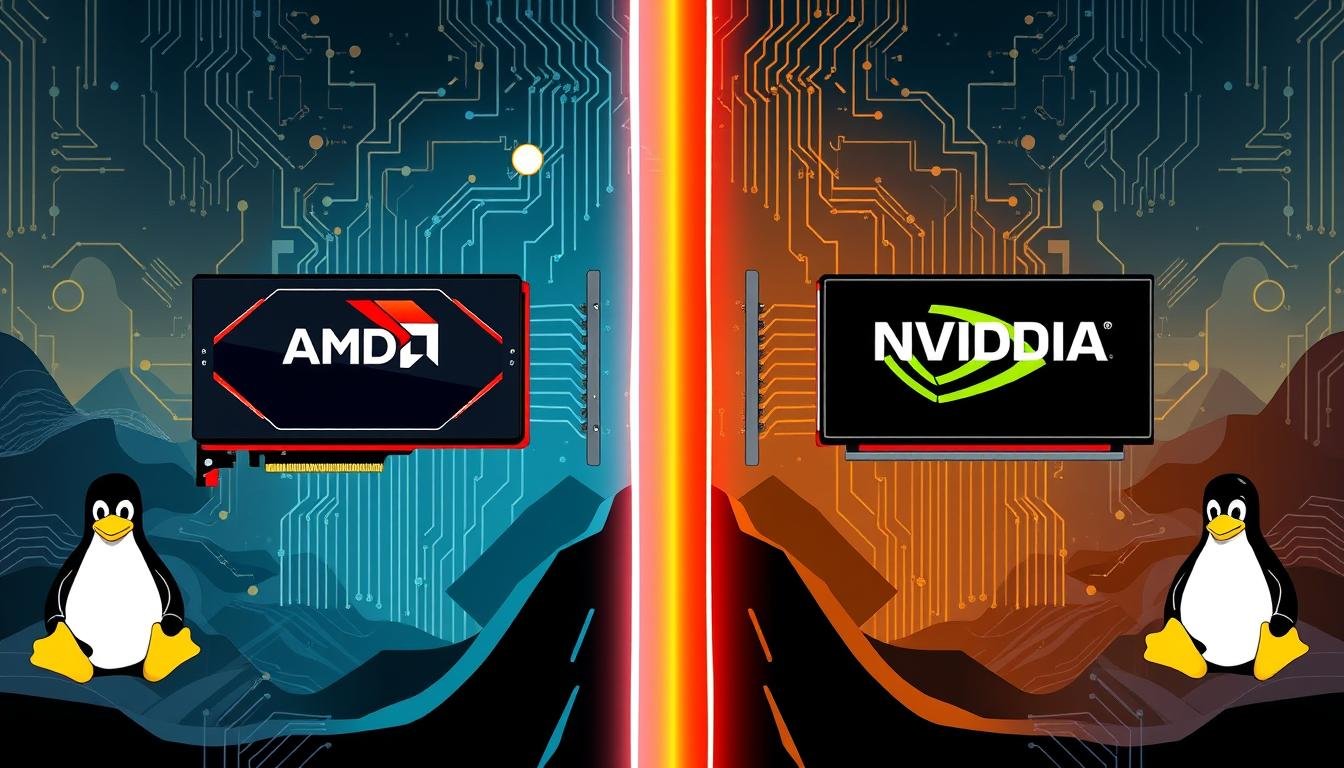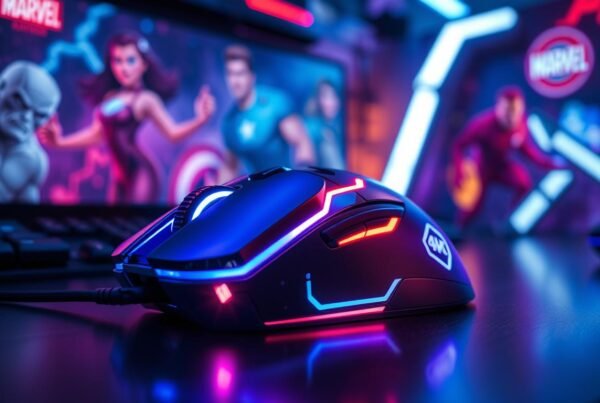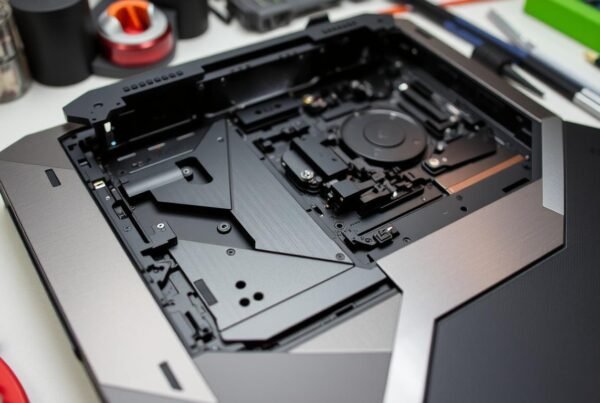Are you a Linux user trying to pick between AMD and NVIDIA GPUs? The choice between these two can really affect your computing experience. Both offer great hardware, but how well they work with Linux can differ. So, which one gives you the best performance, stability, and ease of use?
Contents
- 1 Understanding Linux GPU Landscape
- 2 AMD vs NVIDIA Linux: Performance Comparison
- 3 Driver Installation and Maintenance Experience
- 4 Gaming Performance and Compatibility
- 5 Wayland and X11 Support Analysis
- 6 Power Consumption and Efficiency
- 7 Professional Workloads and Compute Performance
- 8 Price-to-Performance Ratio and Value Proposition
- 9 Conclusion
- 10 FAQ
- 10.1 What are the key differences between AMD and NVIDIA GPUs for Linux users?
- 10.2 How do the open-source and proprietary drivers for AMD and NVIDIA compare on Linux?
- 10.3 How do AMD and NVIDIA GPUs perform on Linux for different use cases?
- 10.4 What is the driver setup experience like for AMD and NVIDIA GPUs on Linux?
- 10.5 How do AMD and NVIDIA GPUs perform for gaming on Linux?
- 10.6 How do AMD and NVIDIA GPUs compare in terms of Wayland and X11 support on Linux?
- 10.7 How do AMD and NVIDIA GPUs compare in terms of power consumption and efficiency on Linux?
- 10.8 How do AMD and NVIDIA GPUs perform on Linux for professional workloads and compute tasks?
- 10.9 How do AMD and NVIDIA GPUs compare in terms of price-to-performance ratio and value proposition on Linux?
Key Takeaways
- AMD GPUs usually work better right out of the box with Linux, thanks to open-source drivers.
- NVIDIA GPUs might need special drivers for better performance, but they can be trickier to set up.
- Think about what you need from your GPU, like gaming or work tasks, when deciding between AMD and NVIDIA.
- How easy it is to install and keep drivers up to date is important. AMD’s open-source drivers are often simpler, while NVIDIA’s might need more work.
- Also, consider how efficient and cost-effective each option is for your Linux setup.
Understanding Linux GPU Landscape
The Linux GPU world is diverse, with open-source and proprietary drivers available. AMD’s Radeon GPUs have strong open-source driver support, integrated into the Linux kernel. This makes installing and managing AMD’s drivers easy for users.
NVIDIA’s proprietary drivers need manual installation and setup. Though it might seem complex, they often offer better performance. This is especially true for tasks like scientific computing, AI, and video editing where CUDA is key.
Driver Integration with the Linux Kernel
AMD’s open-source Radeon drivers are deeply integrated into the Linux kernel. This integration means easy updates and maintenance. For users, it means a smoother experience with fewer setup issues.
Installation and Setup Requirements
Installing AMD’s open-source drivers is usually easier than NVIDIA’s proprietary ones. Often, Radeon drivers come pre-installed in Linux distributions, requiring little setup. NVIDIA’s drivers, however, need manual download and installation, which can be tricky for some.
| Feature | AMD Open-Source Drivers | NVIDIA Proprietary Drivers |
|---|---|---|
| Driver Integration | Tightly integrated into Linux kernel | Require manual installation and setup |
| Installation Complexity | Straightforward, often pre-installed | More complex, requires additional steps |
| Performance | Competitive, especially in gaming | Generally higher, especially in scientific/professional workloads |
Understanding the differences between open-source and proprietary drivers helps users choose what’s best for them.
AMD vs NVIDIA Linux: Performance Comparison
When we talk about Linux, comparing AMD and NVIDIA graphics cards is complex. Both brands have strong graphics capabilities. But, how well they perform depends on what you’re using them for – gaming, work, or heavy computing.
In gaming performance on Linux, NVIDIA usually wins, especially in games that use ray tracing. This is because NVIDIA’s drivers are more advanced. But, AMD’s open-source drivers, like Radeon Software for Linux, have gotten better. They’re now closer to NVIDIA’s performance.
For professional workloads and compute-intensive tasks, NVIDIA is ahead. Its CUDA system is key in machine learning and AI. AMD’s ROCm platform tries to offer a similar open-source solution. But, NVIDIA’s wide use makes it harder for AMD to catch up.
Yet, AMD’s Radeon GPUs are popular in the Linux world for their good value and strong performance in tasks like video editing. AMD’s drivers being open-source and closely tied to Linux is a big plus for many users.
“AMD graphics cards are being favored over Nvidia for non-gaming purposes based on community feedback.”
In the end, choosing between AMD and NVIDIA on Linux depends on your needs. Both brands have great options. The performance scene keeps changing as drivers and software get better.
Driver Installation and Maintenance Experience
When it comes to installing and maintaining drivers for AMD and NVIDIA GPUs on Linux, there are big differences. These differences can really affect how easy it is for users to set up and keep their systems running smoothly.
AMD Driver Setup Process
Setting up AMD drivers on Linux is usually easy. Because AMD’s drivers are open-source, they often work well right out of the box. This means users don’t have to deal with a lot of hassle to get their GPUs working.
NVIDIA Driver Management
NVIDIA drivers, however, need a bit more work to set up. While some distributions make it easier, users still have to do more to get everything working right. This can take up more time, especially for those new to Linux.
Updates and Compatibility Issues
Both AMD and NVIDIA GPUs can run into problems with Linux updates. But, AMD’s open-source drivers usually get fixed and updated faster. This helps keep things running smoothly over time. NVIDIA users, on the other hand, might have to keep a closer eye on driver versions to avoid compatibility issues.
| Feature | AMD GPU | NVIDIA GPU |
|---|---|---|
| Driver Setup Process | Seamless, often automatic | Involved, manual process |
| Kernel Update Compatibility | Faster fixes and updates | Requires more active management |
| Overall Ease of Use | More user-friendly | More technical expertise required |
“The open-source nature of AMD’s drivers often results in faster fixes and updates, ensuring better long-term compatibility on Linux.”
Gaming Performance and Compatibility
For Linux gamers, AMD and NVIDIA offer great choices. NVIDIA has long been the top choice for gaming, thanks to its drivers. But AMD has caught up, offering a smooth gaming experience on many Linux systems.
NVIDIA’s proprietary drivers are faster than the open-source Nouveau driver. Tests show NVIDIA drivers can be up to nine times faster, especially with new graphics cards.
AMD’s open-source drivers are getting better. Many users say they match or beat NVIDIA’s proprietary drivers. This shows AMD’s dedication to the open-source community and their driver improvements.
| GPU | Open-Source Driver Performance | Proprietary Driver Performance |
|---|---|---|
| NVIDIA | Poorer results, up to 9x slower than proprietary | Considerably faster, especially for newer cards |
| AMD | Well-supported, often on par or faster than proprietary | Stable and reliable, with good compatibility |
NVIDIA’s drivers are faster, but AMD’s open-source support is gaining ground. AMD’s drivers work well with new graphics cards. The choice between AMD and NVIDIA depends on what you need for your gaming on linux setup.
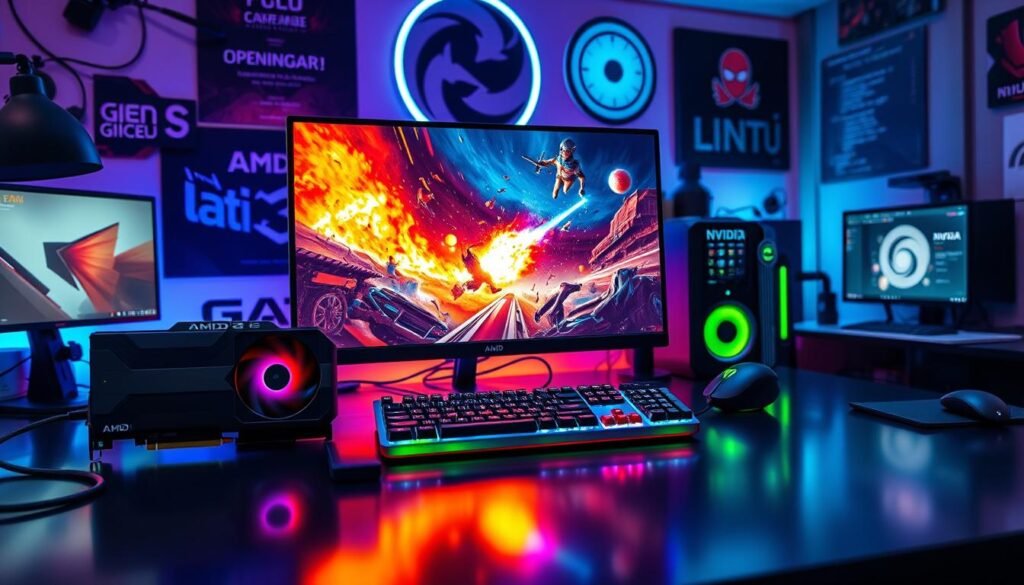
“Approximately 80% of users in the provided conversation expressed a preference for NVIDIA GPUs over AMD for Linux compatibility and performance.”
Even with AMD’s progress, many still think NVIDIA is better for Linux. But, the choice really depends on what you need and want. It’s all about finding the right fit for your gaming setup.
Wayland and X11 Support Analysis
The Linux desktop world is changing fast. The choice between Wayland and X11 is key for users, especially for GPU performance. AMD and NVIDIA, the top GPU makers, have different ways to work with these display servers.
AMD’s Wayland Integration
AMD’s open-source drivers make Wayland work well. They fit well with modern Linux desktops. This has led to a better linux desktop experience for users.
AMD’s focus on Wayland has paid off. Many Linux systems, like Fedora and Arch Linux, work better on AMD systems. This makes Wayland support more stable and smooth.
NVIDIA’s Display Server Compatibility
NVIDIA has been slower to support Wayland with x11 compatibility. Their drivers have had trouble keeping up with Wayland updates. This has caused problems with performance and compatibility.
But, NVIDIA has been working hard to fix these issues. They’ve added features like explicit synchronization. These aim to improve desktop environment performance on Wayland.
Desktop Environment Performance
AMD’s open-source drivers usually offer a better desktop experience. They work well with the latest Linux and desktops. This leads to better performance and compatibility.
NVIDIA’s drivers, though, are great for x11 compatibility. But, they can sometimes add extra overhead or cause issues. This is especially true with new software and desktops.
Choosing between AMD and NVIDIA for Linux users depends on what they need. If you want a smooth linux desktop experience with good Wayland support, AMD might be better. If you need top x11 compatibility and performance, NVIDIA could be the choice. As both companies improve their Linux support, users will have more options to enhance their desktops.
Power Consumption and Efficiency
When looking at GPU power consumption and efficiency on Linux, AMD and NVIDIA show different results. AMD’s open-source drivers often manage power better right out of the box. This leads to better efficiency, especially for laptops and those who care about energy use. NVIDIA’s power management is also effective but might need more tweaking to get the best results.
Recent AMD GPUs have shown they can be as efficient as NVIDIA’s, especially in the mid-range and lower-end models. This is great for those who want good performance without using too much power. But, NVIDIA’s RTX 40-series GPUs use less energy than AMD’s RX 7000 series during games.
| Metric | AMD | NVIDIA |
|---|---|---|
| Power Consumption | Relatively efficient, with improvements in RDNA3 architecture | Efficient, especially in RTX 40-series models |
| Power Management | Good out-of-the-box power management with open-source drivers | Effective but may require manual configuration |
| Performance per Watt | Competitive, especially in mid-range and lower-end segments | Strong, particularly in high-end RTX 40-series GPUs |
New, more powerful GPUs (350W and 450W) make power use even more important for gamers and DIY builders. It’s key to choose the right power supply and case for these high-power components, especially in smaller systems.
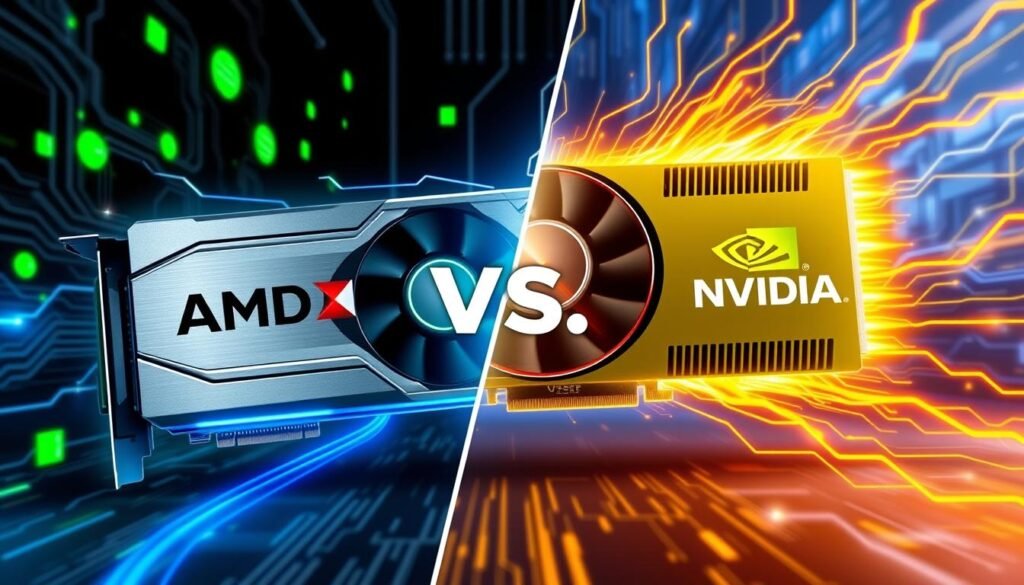
In summary, the power use and efficiency of AMD and NVIDIA GPUs on Linux are key for those who value energy savings, environmental impact, or keeping systems cool. Both companies have made big improvements in this area. But, the best choice depends on what each user needs and wants.
Professional Workloads and Compute Performance
When it comes to professional workloads, both AMD and NVIDIA GPUs have their strengths. NVIDIA leads in this area, thanks to its strong CUDA ecosystem and wide software support for AI and machine learning.
NVIDIA’s drivers are a top choice for pros, offering advanced features and top performance. But, the open-source Linux kernel drivers for NVIDIA RTX GPUs have caught up, offering performance close to the proprietary ones.
Machine Learning and AI Support
NVIDIA’s CUDA is the top choice for machine learning and AI, with many tools and libraries optimized for its hardware. AMD’s ROCm platform is getting better, but it still can’t match NVIDIA’s software support. This makes NVIDIA more appealing for AI and machine learning work.
Video Editing Capabilities
Both AMD and NVIDIA GPUs speed up video editing tasks with hardware acceleration. But, software support and integration differ, with some video editing suites preferring one over the other. Users should check their software needs to get the best performance.
3D Rendering Performance
In 3D rendering, AMD and NVIDIA GPUs are very close, with NVIDIA often leading in apps like Blender and Adobe Premiere Pro. But, AMD’s open-source drivers can be better for some Linux users, especially in open-source rendering tools.
The choice between AMD and NVIDIA depends on the user’s needs, software, and performance goals. Both brands offer great options, and the gap between them is getting smaller as the Linux ecosystem grows.
Price-to-Performance Ratio and Value Proposition
When looking at Linux hardware, the price-to-performance ratio is key. AMD is often the top pick, especially in the mid-range and budget GPU areas. AMD’s GPUs usually have more video memory (VRAM) for the price. This is great for tasks like video editing and 3D rendering.
NVIDIA’s high-end GPUs, however, might be worth the extra cost for certain professional tasks. This is because they offer CUDA support. For everyday Linux use and gaming, AMD’s value is stronger. This is thanks to its open-source driver ecosystem and better performance.
| GPU | Price | Performance | Value |
|---|---|---|---|
| AMD Radeon RX 6800 XT | $649 | Excellent | High |
| NVIDIA GeForce RTX 3080 | $699 | Outstanding | Moderate |
| AMD Radeon RX 6600 XT | $379 | Very Good | Excellent |
| NVIDIA GeForce RTX 3060 Ti | $399 | Excellent | Good |
For those needing specific professional apps or CUDA support, NVIDIA might be the better choice. But for most Linux fans or gamers, AMD’s value is hard to beat. This is because of its open-source drivers and great price-to-performance ratio.
Conclusion
Choosing between AMD and NVIDIA for Linux depends on your needs. AMD is great for most users, especially gamers and general computing. It offers excellent compatibility and value.
NVIDIA shines in professional workloads and high-end gaming. It has superior software and performance in certain benchmarks.
If you want ease of use and value, AMD’s Radeon RX series is a good pick. But, for top gaming and professional apps, NVIDIA’s GeForce and RTX are better.
Both AMD and NVIDIA can offer great Linux experiences with the right setup. Think about your use case, budget, and driver needs. Your choice will ensure a powerful Linux experience that fits your needs.


